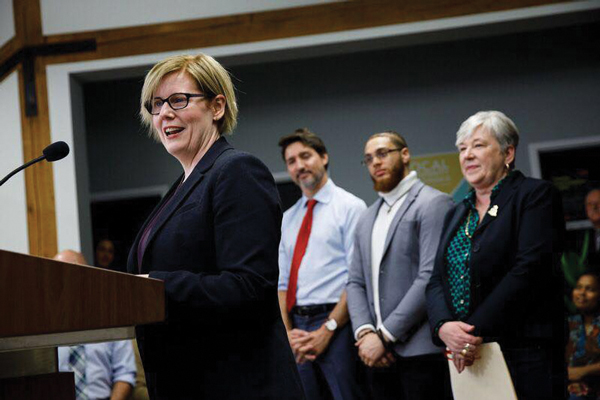
The federal government has announced its plan to transition Canadians on the Canada Emergency Response Benefit (CERB) into a revamped Employment Insurance (EI) program. The plan also details three new recovery benefits.
The financial aid is expected to cost $37 billion.
Finance Minister and Deputy Prime Minister Chrystia Freeland and Employment, Workforce Development and Disability Inclusion Minister Carla Qualtrough held a news conference to make the announcements on Thursday.
Freeland said that as the country continues into the next phase of recovery from COVID-19, the government’s approach must also evolve.
“We have had some success in flattening the curve of the pandemic, but we’re not out of the woods yet and we are contending with the worst economic downturn since the Great Depression,” she said.
“There continues to be an ongoing public health crisis in our country and we need to prepare for other possible economic shutdowns due to outbreaks or future COVID-19 waves,” added Qualtrough, who took the lead on developing the plan.
CERB, which pays each eligible person $2,000 a month, will be extended four weeks until Sept. 27 for a total of 28 weeks.
According to a news release, CERB has helped over 8.5 million people pay their bills. More than 4 million people have transitioned off of CERB and returned to work.
With CERB and the Canada Emergency Wage Subsidy (CEWS) being “the bedrock” of the government’s economic response, said Freeland, they’ve decided to extend it as the economy reopens. Then, those eligible will transition to a “more flexible and generous” EI program.
Millions of Canadians will only need 120 insurable hours to access the EI benefit.
Those receiving EI will be eligible for a taxable benefit rate of at least $400 per week, or $240 per week for extended parental benefits. Regular benefits will also be accessible for a minimum duration of 26 weeks.
The news release said the reformed program is anticipated to benefit about 400,000 more people.
“I want to highlight the importance of these changes for expectant and new parents, mothers in particular. Many parents have not been able to accumulate the work hours necessary to claim EI maternity or parental benefits,” said Qualtrough.
The government will also freeze the EI insurance premium rates at 2020 levels for two years.
Workers will continue to benefit from the EI insurance premium rate of $1.58 per $100 dollars of insurable earnings, and employers will be frozen at $2.21 per $100 of insurable earnings. Both of those levels are the lowest since 1980, said Freeland.
The government is also proposing three new benefits: The Canada Recovery Benefit, Canada Recovery Sickness Benefit and Canada Recovery Caregiving Benefit.
The recovery benefit will provide $400 per week for up to 26 weeks to workers who are self-employed or not eligible for EI and still require income support, are available and looking for work.
The recovery sickness benefit is for workers who are sick or must self-isolate because of COVID-19. It will provide $500 for up to two weeks.
Lastly, the recovery caregiving benefit will provide $500 per week for up to 26 weeks per household. It applies to eligible Canadians unable to work because they’re caring for:
- A child under age 12 due to the closures of schools or daycares because of COVID-19
- A family member with a disability or a dependent because their day program or care facility is closed due to COVID-19
- A child, a family member with a disability, or a dependent who is not attending school, daycare, or other care facilities under the advice of a medical professional due to being at high-risk if they contract COVID-19
Qualtrough said they intend to introduce legislation to create these benefits within the first week after returning to parliament.
Response from the CFIB
The Canadian Federation of Independent Business (CFIB) welcomed these changes, but is concerned that it will pose challenges for small business employers.
Workers will now be able to collect EI benefits for up to 26 weeks after 120 hours of work over the past year, said the CFIB’s statement.
This means that a worker with three and a half weeks of total work, or under three hours per week, over the past year will qualify for over $10,000 worth of benefits if they don’t return.
“When I was in Grade 9, I worked three hours every Friday night washing dishes at a pizza restaurant in Winnipeg. This is just too low a bar and will serve as a disincentive for many part-time workers to return to their pre-COVID employment,” said CFIB President Dan Kelly.
“I expect that retail, hospitality, arts and recreation and service sector businesses—the very sectors hardest hit by the economic effects of COVID-19—will struggle to bring back their part-time workforce.”
The organization is concerned that these changes will be made permanent.
The CFIB is asking the government to ensure the changes are temporary, raise the bar for the number of hours worked to receive the benefits and to create a system to end benefits for workers who have been recalled to their pre-COVID jobs.

